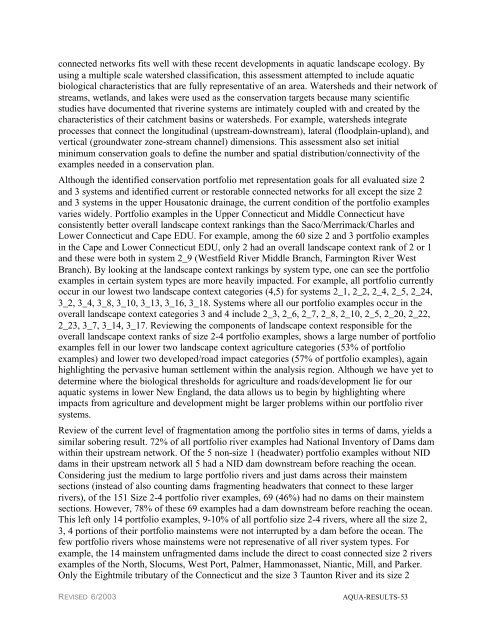Full ecoregional plan - Conservation Gateway
Full ecoregional plan - Conservation Gateway
Full ecoregional plan - Conservation Gateway
- No tags were found...
You also want an ePaper? Increase the reach of your titles
YUMPU automatically turns print PDFs into web optimized ePapers that Google loves.
connected networks fits well with these recent developments in aquatic landscape ecology. Byusing a multiple scale watershed classification, this assessment attempted to include aquaticbiological characteristics that are fully representative of an area. Watersheds and their network ofstreams, wetlands, and lakes were used as the conservation targets because many scientificstudies have documented that riverine systems are intimately coupled with and created by thecharacteristics of their catchment basins or watersheds. For example, watersheds integrateprocesses that connect the longitudinal (upstream-downstream), lateral (floodplain-u<strong>plan</strong>d), andvertical (groundwater zone-stream channel) dimensions. This assessment also set initialminimum conservation goals to define the number and spatial distribution/connectivity of theexamples needed in a conservation <strong>plan</strong>.Although the identified conservation portfolio met representation goals for all evaluated size 2and 3 systems and identified current or restorable connected networks for all except the size 2and 3 systems in the upper Housatonic drainage, the current condition of the portfolio examplesvaries widely. Portfolio examples in the Upper Connecticut and Middle Connecticut haveconsistently better overall landscape context rankings than the Saco/Merrimack/Charles andLower Connecticut and Cape EDU. For example, among the 60 size 2 and 3 portfolio examplesin the Cape and Lower Connecticut EDU, only 2 had an overall landscape context rank of 2 or 1and these were both in system 2_9 (Westfield River Middle Branch, Farmington River WestBranch). By looking at the landscape context rankings by system type, one can see the portfolioexamples in certain system types are more heavily impacted. For example, all portfolio currentlyoccur in our lowest two landscape context categories (4,5) for systems 2_1, 2_2, 2_4, 2_5, 2_24,3_2, 3_4, 3_8, 3_10, 3_13, 3_16, 3_18. Systems where all our portfolio examples occur in theoverall landscape context categories 3 and 4 include 2_3, 2_6, 2_7, 2_8, 2_10, 2_5, 2_20, 2_22,2_23, 3_7, 3_14, 3_17. Reviewing the components of landscape context responsible for theoverall landscape context ranks of size 2-4 portfolio examples, shows a large number of portfolioexamples fell in our lower two landscape context agriculture categories (53% of portfolioexamples) and lower two developed/road impact categories (57% of portfolio examples), againhighlighting the pervasive human settlement within the analysis region. Although we have yet todetermine where the biological thresholds for agriculture and roads/development lie for ouraquatic systems in lower New England, the data allows us to begin by highlighting whereimpacts from agriculture and development might be larger problems within our portfolio riversystems.Review of the current level of fragmentation among the portfolio sites in terms of dams, yields asimilar sobering result. 72% of all portfolio river examples had National Inventory of Dams damwithin their upstream network. Of the 5 non-size 1 (headwater) portfolio examples without NIDdams in their upstream network all 5 had a NID dam downstream before reaching the ocean.Considering just the medium to large portfolio rivers and just dams across their mainstemsections (instead of also counting dams fragmenting headwaters that connect to these largerrivers), of the 151 Size 2-4 portfolio river examples, 69 (46%) had no dams on their mainstemsections. However, 78% of these 69 examples had a dam downstream before reaching the ocean.This left only 14 portfolio examples, 9-10% of all portfolio size 2-4 rivers, where all the size 2,3, 4 portions of their portfolio mainstems were not interrupted by a dam before the ocean. Thefew portfolio rivers whose mainstems were not represenative of all river system types. Forexample, the 14 mainstem unfragmented dams include the direct to coast connected size 2 riversexamples of the North, Slocums, West Port, Palmer, Hammonasset, Niantic, Mill, and Parker.Only the Eightmile tributary of the Connecticut and the size 3 Taunton River and its size 2REVISED 6/2003AQUA-RESULTS-53
















